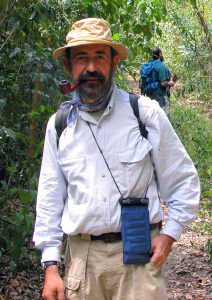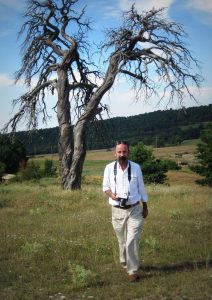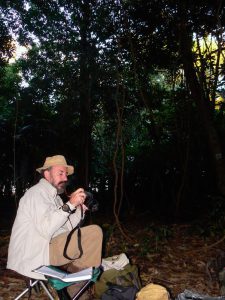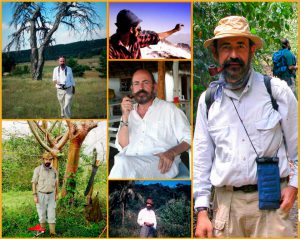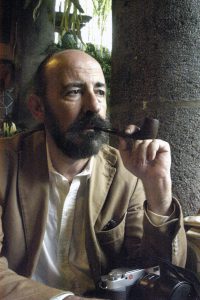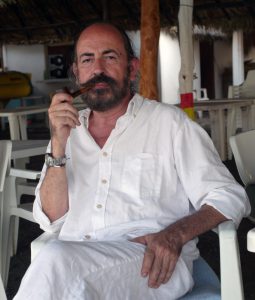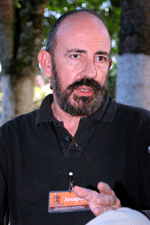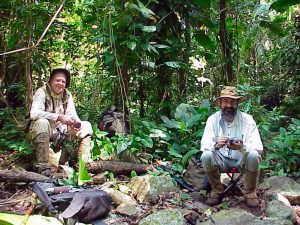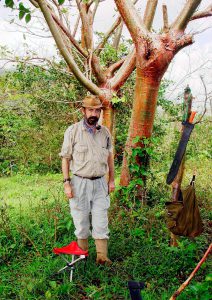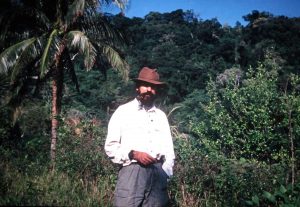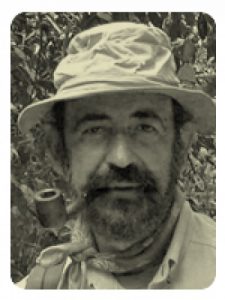
Career trajectory
JoaquimVeà, from the neighbourhood of San Andrés de Palomar in Barcelona, was born on the 11th October, 1958. He completed his degree in Psychology at the University of Barcelona in 1983, and three years later, in 1986, his doctorate with a thesis on animal behaviour, named “Functional models in animal behaviour: simulation of a motivational system”.
Even before completing his degree he published “IQ and individual differences” (1982), and from 1983 he started to become interested in issues of animal behaviour, a subject on which he developed his doctoral thesis after publishing “Cognitive processes in animal behaviour: an psycholinguistic application” (1983) and “Symbolic behaviour in the white rat: simulation of the learning of words” (1986), pieces of work which analysed the possibilities of extrapolating to humans the results of behavioural experiments on lower animals.
Veà was a close associate and protégée of the doctor and discoverer of the white gorilla Copito de Nieve, Jordi Sabater Pi, with whom he shared research work on bonobos and pygmy chimpanzees in the jungle of Zaire in 1988. Research he conducted within the period 1985-1996 focused on behavioural variability and the processes of adaption. On top of joint publications with Sabater Pi, various studies on primate behaviour stand out from this period, including “Instrumental behaviour of the chimpanzee (Pan troglodytes) in its natural habitat” (1988), and “Innovation and diffusion of behaviour patterns in primate societies: the birth of culture” (1990). He also accompanied Sabater Pi in 1997 when he was president of the Spanish Association of Primatology, Veà acting as vice-president.
In the year 2000 he completed an award-winning project on the fauna reserve of Conkovati (Congo-Brazzaville).
Relationship with Veracruz
Veà’s relationship with the University of Veracruz began in 1997 when he participated in an exchange programme for university professors organised by the Spanish Agency for International Cooperation, which he repeated in 1998 and again in 1999. It was in Veracruz where he met Ernesto Rodríguez Luna, with whom he continued to collaborate later on.
This first contact permitted him to sign an agreement of collaboration between the Faculty of Psychology at the University of Barcelona and the Institute of Neuroethology at the University of Veracruz in 2000.
In the year 2001 he first came into contact with the Los Tuxtlas jungle in Veracruz, Mexico. Considered the most northern jungle on the planet and declared a biosphere reserve by UNESCO, Veà saw an opportunity to deepen the study of ethological factors initiated by Sabater Pi.
From 2002 he extended the institutional collaboration incorporating students from both universities in the investigation work in the jungle. This permitted the participation of fifty students in the first ten years, whose work is summed up in twenty theses on aspects related to alouatta palliate populations, studied in-situ, half of which Joaquim Veà himself supervised.
In 2005 he began to research the effects of isolation in “fragments of rainforest” – caused by deforestation – on the populations of alouatta. The alouatta are tree-dwelling animals that live virtually without touching the ground; the fragmentation of the rainforest causes them to become immobilized in one area.
In 2011 he undertook a new campaign in Los Tuxtlas, in the volcanic area of San Martín, part of a joint project between the University of Barcelona and the University of Veracruz. The team, co-directed by Joaquim Veà and Ernesto Rodríguez Luna from the Mexican university, investigated the impact of territorial fragmentation on the conservation of the alouatta palliata. Although the species is not endangered on a global scale, within the jungle of Veracruz researchers have detected a decrease in the population, inspiring this collaborative work of analysis.
One of the reasons behind the decrease is due to the competition with humans for space. Speaking of this topic, Veà stated in 2011: “We have to plan how human populations are going to live alongside conservation policies in this habitat. We cannot trust in ‘sustainable’ use of natural resources, because when humans aren’t able to extract the resources they want, the process intensifies, breaking the ecological equilibrium. It is therefore vital to include the human population in conservation policies”.
In order to monitor the possible migration of different isolated spaces within the jungle, they launched a programme of genetic monitoring of populations in collaboration with the University of Cambridge.
The results of the studies on the fragmentation of populations identified an increase in stress, especially among females, when a male from outside the group approached the area, because they felt that their offspring are being threatened. In addition, food limitation in areas of reduced surface area was forcing individuals to adapt their diet to increased food deprivation. Veà highlighted that “although this situation revealed up to what point individuals have the capacity for adaption, in some cases, undernourishment can lead to health problems that would make the population inviable”. Results can be compared to humans who “do not always eat everything which they should, for example in underdeveloped countries that have problems with malnutrition, rickets, a range of illnesses, but this does not put an end to the population, but rather provokes them to change their characteristics”.
Special Centre of Primate Research
Since 1991, research groups at the University of Barcelona interested in the origin of the human species and primate behaviour have been working in collaboration, a unique initiative in the international sphere. For the first time, the study of evolution and the behaviour of the human species, as well as of other primates, was being conducted between research teams from different backgrounds: Evolution of Hominids and Other Primates; HOMINID, Human Origins Group, and Information Technology in Behavioural Sciences. This collection of researchers constituted the Special Centre of Primate Research (CERP), of which Joaquim Veà was director. It is from this centre, at the University of Barcelona, from which all field work on primates is coordinated.
Teaching activities
In the latter phase of his life, Veà was appointed tenured professor of the Department of Psychiatry and Clinical Psychobiology at the University of Barcelona.
He supervised twelve doctoral theses related to the research of primates in Veracruz, at the Autonomous University of Madrid and the University of Barcelona.
He was also part of the scientific council for different international postgraduate studies, such as “Animal Behaviour and Portugal Primatology” – Mexico 2008-2009.
Other activities
Joaquim Veà was a multitalented person, an avid reader, concerned about the society which surrounded him. He was capable of combining activities such as being a voluntary fireman with educational actions on human communication. His cultural inquisitiveness allowed him to link with the Sitges Historical Studies Centre from its foundation in 1975, and he was appointed chair of the organisation in 1992.
Photography as a basic tool for any researcher became one of Veà’s passions, and he was able turn functional and scientific photography into works of art. For his photographic work, the scientist used the pseudonym Ricard Baró. He had held various exhibitions in Sitges, Barcelona and in Mexico, where he had the support of Rosa María López, director of the Fototeca Juan Malpica Mimendi in the port of Veracruz, who he met on one of his trips and was later to be his wife. Dedicated to photography since the 1980s, he moved from analogue to digital and developed a style based on digital processing and the saturation of colour to create magical photographs.
He often took photographs of the female nude, and of nature in the jungle of Veracruz. In an exhibition in Xalapa under the title “The naked tremor of slim trees”, Ricardo Barí used his images to demonstrate the human pressure on the jungle which he had observed in his research:
“The trees hold up the sky” said our ancestorsAnd they know, the sky is now falling on top of usIs it possible to show the beauty of disaster? I think so.Ricard Baró (Joaquim Veà’s pseudonym)
The last exhibition was held at the Mexican embassy of Barcelona in December 2015, when Veà had advanced cancer which would end his life a year later, and was a special tribute from the Mexican authorities for his professional involvement with the state of Veracruz and its natural reserve over the last 15 years.
He died in Barcelona on the 23rd February 2016, two years after his illness was diagnosed.
Main Works
- Veà Baro, J.J. Cociente intelectual y diferencias individuales (in Spanish). Oikos-Tau, 1982. ISBN 84-281-0508-1.
- Veà Baró, J.J.; Colell, Montserrat. Etología. Universidad de Barcelona, 1997. ISBN 84-922004-5-6.
- ·Sabater Pi, Jordi; Veà Baró, J.J.. Nest building and population estimates of the bonobo from the Lokofe-Lilungu-Ikomaloki Region of Zaire, 1990.
- Sabater Pi, Jordi; Veà Baró, J.J.. Estudio eto-ecológico del chimpance bonobo (Pan paniscus) de la región de Lokofe-Lilungu-Ikomakoli (Dist. de Ikela) Zaire (in Spanish), 1990.
- Veà Baró, J.J.; Sabater Pi, Jordi. Técnicas para el estudio de los primates en su hábitat natural (in Spanish). Universidad de Barcelona. Departamento de Psiquiatría y Psicobiologia Clínica, 1995.
- Veà Baró, J.J.; Colell Mimó, Montserrat. Etología. Ediciones Universitat Barcelona, 1997. ISBN 9788492200450 [Enquiry: 23rd December 2015].
- Veà Baró, J.J.; Sabater Pi. «Técnicas para lo estudio de la conducta de los primates en su habitado natural». A: Observación en etología (animal-humana) (in Spanish). Ediciones Universidad Barcelona, 1999. ISBN 9788483381113 [Enquiry: 23rd December 2015].
- Martínez Contreras, Jorge; Veà Baró, J.J.. Primates : evolución, cultura y diversidad : homenaje a Jordi Sabater Pí (in Spanish). México, D.F.: Centro de Estudios Filosóficos, Políticos y Sociales Vicente Lombardo Toledano, 2002.
- Veà Baró, J.J. Primates: Origin, Evolution and Behaviour. Parco Científico de Barcelona, 2003. ISBN 9788460766360.

